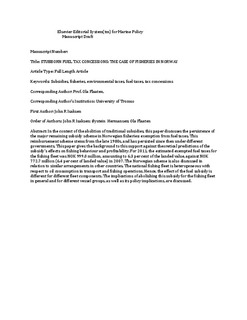| dc.description.abstract | In the context of the abolition of traditional subsidies, this paper discusses the persistence of the major remaining subsidy scheme in Norwegian fisheries: exemption from fuel taxes. This reimbursement scheme stems from the late1980s, and has persisted since then under different governments. This paper gives the background to this support against theoretical predictions of the subsidy's effects on fishing behavior and profitability. For 2011, the estimated exempted fuel taxes for the fishing fleet was NOK 999.0 million, amounting to 6.3 percent of the landed value, against NOK 772.7 million (6.4 per cent of landed value) in 2007. The Norwegian scheme is also discussed in relation to similar arrangements in other countries. The national fishing fleet is heterogeneous with respect to oil consumption in transport and fishing operations. Hence, the effect of the fuel subsidy is different for different fleet components. The implications of abolishing this subsidy for the fishing fleet in general and for different vessel groups, as well as its policy implications, are discussed. | |
